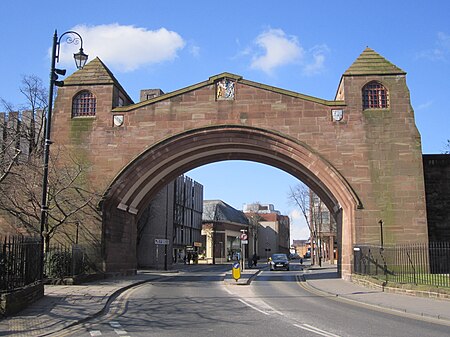Newgate, Chester

Newgate is an arch bridge carrying the walkway of the city walls over Pepper Street in Chester, Cheshire, England. It is recorded in the National Heritage List for England as a designated Grade II listed building. The bridge was built in 1937–38 to relieve traffic congestion in the city, especially at Chester Cross. This involved making a new breach in the city walls.The bridge is constructed in red sandstone. It was designed by Sir Walter Tapper and his son, Michael. On each side of the bridge is a tower containing mock loops (unglazed slit windows) and surmounted by hipped roofs. Flights of steps on each side lead up to the towers and to the walkway across the top of the bridge. The structure is decorated with carved shields and Tudor roses. The historian Simon Ward expresses the opinion that "its design conformed to the generally medieval feel of the walls".
Excerpt from the Wikipedia article Newgate, Chester (License: CC BY-SA 3.0, Authors, Images).Newgate, Chester
Newgate, Chester Handbridge
Geographical coordinates (GPS) Address External links Nearby Places Show on map
Geographical coordinates (GPS)
| Latitude | Longitude |
|---|---|
| N 53.18902 ° | E -2.88819 ° |
Address
Newgate
Newgate
CH1 1DE Chester, Handbridge
England, United Kingdom
Open on Google Maps










